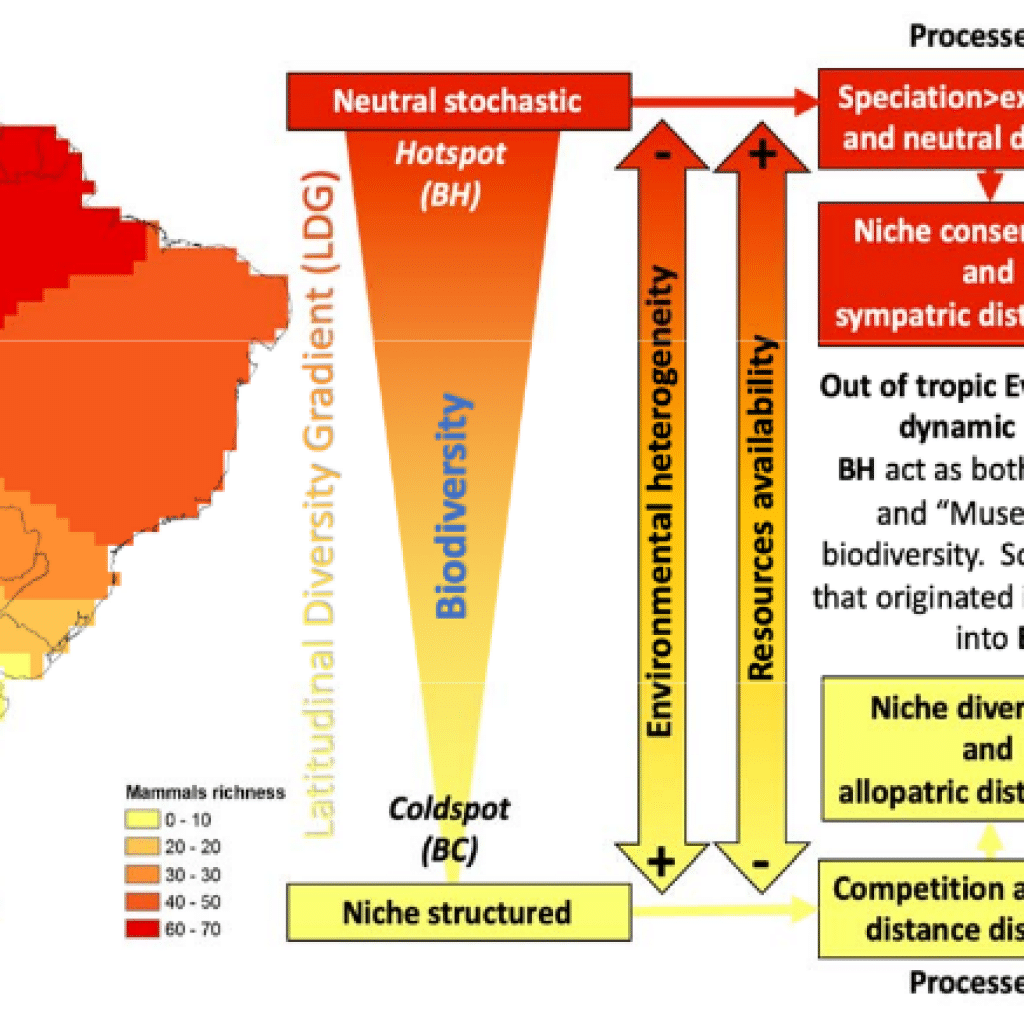A macroecological integration of niche differentiation and neutral theory to explain the geographic variation of Neotropical mammal biodiversity: effects at the macroevolutionary scale
hat drives species diversity and why it is not uniformly distributed over space or taxonomic groups are fundamental questions in ecology and evolution. Although a wide range of hypotheses have been proposed to explain the origin and complexity of extant biodiversity, significant challenges remain. For example, we still do not understand two of the most striking patterns of Neotropical biota: the distinctive presence of biodiversity hotspots (BHs) and the Latitudinal Diversity Gradient (LDG). Scientific efforts have been focused on an ecological perspective, and emphasize the importance of deterministic processes based on niche differences between species (niche theory). This suggests that species richness is maintained by environmental factors and originates from environmental heterogeneity. However, this view has been challenged by the ‘‘neutral theory’’, which provocatively states that biological differences between species, like competitive ability, are irrelevant (neutral) to their success within communities. This suggests that diversity originates from a balance between immigration, speciation, and extinction; which is coherent with macroevolutionary theory. Here we propose integrating the neutral, ecological and macroevolutionary perspectives to explain the BHs and LDG, and to untangle the macroevolutionary scope of niche and neutral theory in order to move to a better understanding of biodiversity dynamics. We propose that biodiversity distribution can be explained by a continuum between neutral and niche structured biodiversity areas, and the macroevolutionary consequences of this macroecological integration are the result of two extremes: 1.- highly diverse areas operate in a more neutral-stochastic, being modulated by the interplay between neutral speciation, extinction, and local dispersion – where competition does not play a fundamental role -, and species accumulate randomly over time in a long term stable environments (tropical areas); 2.- low diverse areas operate in a more niche-structured fashion, being dominated by the interplay between variation in historical dispersal ability, competition, and spatial and temporal environmental heterogeneity – where, competition plays a fundamental role-, and only a few species can survive over time because of the low resources (extratropical areas). Based on this context, we hypothesize that “The macroevolutionary connection between the biodiversity of neutral and niche structured areas is an out of tropic evolutionary-dynamic (OTT).
Consequently, highly diverse areas (BHs or tropical areas in the LDG) are neutral (i.e. stable environments with high availability of resources) and act as both “Cradles” and “Museums” of biodiversity; and some taxa that originated in these areas spread into niche structured areas (BCs), where only a few species can survive given the competition and the spatial and temporal environmental heterogeneity”.
We propose to evaluate this hypothesis, using as a study model the Neotropical mammals, and complementary approaches from the spatial macroecology, the comparative phylogenetic method, and historical biogeography. We will generate an improved database of the Neotropical mammalian distributions using international electronic available data, literature sources, and new data from local museum collections. Secondly, we will use a completely resolved supertree of mammal species and a new environmental database to evaluate the following expectations:
- Species inhabiting highly diverse areas will show high niche conservatism and species inhabiting low diverse areas will show high niche divergence (this will be assessed in space by the selection of Ecological Niche Models together with an Identity test and Background test, and in time by phylogenetic variable rates regression models)
- Highly diverse areas will show a high probability of sympatric distribution, higher speciation rates and/or lowest extinction rates, and high emigration rate (this will be assessed in space by Joint Species Distribution Model selection and Multivariate probit regression method, and in time by Biogeographic Stochastic Mapping (BSM) implemented in BioGeoBEARS and Hidden Geographic State Speciation and Extinction approach or GeoHiSSE model)
- Low diverse areas will show a high probability of allopatric distribution, and higher immigration rates, low speciation rates, and/or highest extinction rates (this will be assessed in space by Joint Species Distribution Model selection and Multivariate probit regression method, and in time by the Biogeographic Stochastic Mapping (BSM) implemented in BioGeoBEARS and Hidden Geographic State Speciation and Extinction approach or GeoHiSSE model).

